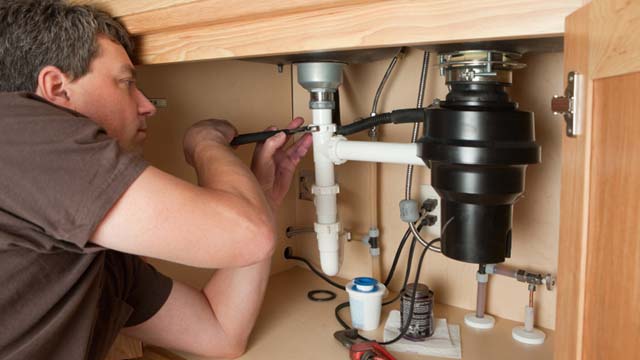An Guide to Resolving a Leak in Your Garbage Disposal
An Guide to Resolving a Leak in Your Garbage Disposal
Blog Article
What are your thoughts about Tips on Fixing a Leaking Garbage Disposal?

Garbage disposals are essential cooking area devices that assist in disposing of food waste successfully. Nevertheless, a dripping garbage disposal can be an irritating and messy trouble to manage. The good news is, many leaks can be dealt with easily with a couple of simple actions. In this write-up, we will go over exactly how to deal with a dripping waste disposal unit effectively.
Intro
Waste disposal unit are mounted under cooking area sinks and are created to shred food waste into smaller items, enabling it to go through the plumbing system conveniently. While these tools are generally trustworthy, leaks can happen gradually because of deterioration, loose links, or damages to the device.
Step-by-Step Guide to Fixing a Dripping Garbage Disposal
Turn Off the Power
Prior to trying any repairs, make certain that the power to the waste disposal unit unit is switched off to prevent the threat of electric shock.
Find the Leakage
Identify the precise location of the leak and establish the cause
Tighten up Links
Utilize a wrench to tighten any loosened connections between the disposal unit and the pipes system.
Change Seals or Gaskets
If the leak is because of used seals or gaskets, eliminate the old components and change them with new ones.
Patching Fractures or Holes
For fractures or holes in the disposal device, usage epoxy or an ideal patching product to secure the damaged location.
Recognizing the Resource of the Leakage
Prior to attempting to take care of a dripping garbage disposal, it is important to identify the source of the leak. This can commonly be done with visual examination or by performing easy examinations.
Visual Assessment
Examine the garbage disposal system meticulously for any indicators of water leakage. Pay close attention to areas around seals, gaskets, and link factors.
Evaluating for Leakages
One means to evaluate for leakages is by running water via the disposal device and checking for any kind of visible indications of leak.
Typical Sources Of Leakages in Rubbish Disposals
Worn Seals and Gaskets
Seals and gaskets play a critical role in preventing water from leaking out of the garbage disposal. Over time, these components can degrade, leading to leaks around the disposal system.
Loose Links
The connections in between the waste disposal unit and the pipes system can come to be loosened in time, causing water to leak out throughout procedure.
Cracks or Holes in the Disposal Device
Physical damages to the garbage disposal, such as cracks or openings in the housing, can additionally result in leakages.
Devices and Materials Needed for Dealing With a Leaking Waste Disposal Unit
Before beginning the repair process, collect the necessary tools and materials, including a screwdriver, flexible wrench, plumber's putty, substitute seals or gaskets, and epoxy or patching product for repairing fractures or openings.
Evaluating the Garbage Disposal After Repair Work
Once the repair is complete, examine the garbage disposal by running water via it to make sure that the leak has actually been fixed.
Preventive Maintenance Tips to Prevent Future Leakages
To prevent future leakages, it is essential to do normal upkeep on your garbage disposal. This includes maintaining it tidy, preventing placing non-food products or tough things down the disposal, and regularly checking for leakages or various other problems.
Conclusion
Finally, dealing with a leaking waste disposal unit is a fairly uncomplicated process that can be finished with basic devices and products. By complying with the actions outlined in this post and practicing precautionary upkeep, you can maintain your garbage disposal in good working condition and stay clear of pricey fixings in the future.
HERE’S HOW TO FIX YOUR GARBAGE DISPOSAL
WHAT TO DO IF SOMETHING IS STUCK IN YOUR GARBAGE DISPOSAL
If the impeller won’t turn, there’s probably something stuck in the disposal. It could be a steak bone or peach pit, although plumbers report pulling all sorts of inappropriate objects out of disposals, such as bottle caps or aluminum foil. Make sure power to the disposal is off, and look inside to see if you can see the source of the jam.
Never stick your fingers in a disposal. Pull out anything you see with tongs or pliers.
If the disposal still won’t work, it may be time to call a plumber or consider buying a new disposal. GEM Plumbing & Heating is here for all of your garbage disposal needs.
WHAT TO DO IF YOUR GARBAGE DISPOSAL DRAIN IS CLOGGED
Take everything out from underneath your sink and put a bucket or other container under your disposal to catch any water that drains out. Disconnect your disposal from the power supply. If it’s plugged into a wall outlet, unplug it. If it’s hardwired into an electrical box, go to the electrical panel and turn off the breaker for the disposal. Pour ¼ cup of baking soda into the drain, followed by ½ cup of white vinegar. Give the solution a few minutes to fizz and do its work. Look into the disposal with a flashlight to see if you can see an object that might be causing the clog. If you see it, remove it using tongs or pliers. MORE TIPS ON DEALING WITH A CLOGGED GARBAGE DISPOSAL
Never use drain cleaner in a garbage disposal. It can damage the plastic parts inside the disposal. You can also be splashed with the caustic liquid while working to clear the clog. Beware! Never stick your fingers into a garbage disposal. Trust us — not a good idea. In many instances, your dishwasher drains through your garbage disposal. This allows the disposal to grind any large food particles that may be drained out of your dishwasher. There are some jurisdictions, however, where the plumbing code prohibits such a connection. WHAT TO DO WHEN YOUR DISHWASHER DRAINS THROUGH THE DISPOSAL
Run some water in the sink so your plunger has at least a ½-inch of water to create a seal and plunge vigorously up and down several times. You may need to repeat this several times. Run hot water down the drain to clear any residue that remains.

I was shown that editorial about Why Is from an acquaintance on our other blog. Those who appreciated our blog post kindly be sure to share it. Bless you for your time. Visit again soon.
Contact Us Now Report this page